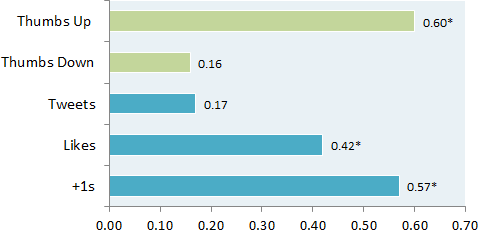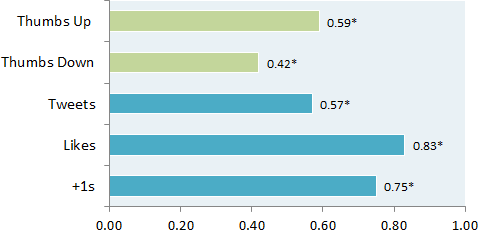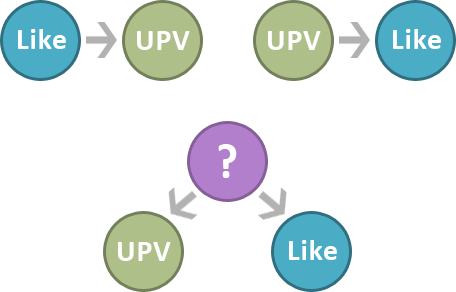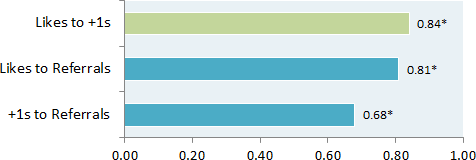
Do Social Signals Drive Traffic?
As a regular blogger on SEOmoz, I’m very interested in what drives traffic to our posts. Of course, there’s the usual realm of referrers and keywords, but lately I’ve been curious about how social signals (including Google’s new +1) correlate with traffic. In other words, how much more traffic will a post get because it gets more Tweets, Likes, or +1s?
So, I set out to do an informal correlation study, looking at how Tweets, Likes, +1, and our own internal social metrics – Thumbs Up and Thumbs Down – impact Unique Pageviews (UPVs) over two sets of data. The first set is the Top 50 posts (by UPVs) for the first half of 2011. The second set is all main-blog posts after the launch of Google+.
(1) Top 50 Posts of 2011
The first study was pretty straightforward. I looked at the traffic for all main-blog posts (including promoted YOUmoz posts) from January 1st to June 30th of 2011 and pulled the Top 50 by Unique Pageviews. For each post, I gathered data on Thumbs Up, Thumbs Down, Tweets, Likes and +1s, and calculated their correlations with UPVs. The graph below shows the correlations:

Just a quick refresher – the correlation coefficient (r) varies from -1 to 1, with 0 indicating no relationship and 1 being a perfect positive correlation (when one variable goes up, the other variable goes up). Correlation does not imply causation, but I’ll get into the details of that below, because it’s very interesting for this data set. On a technical note, these are Spearman correlations – the social signal data isn’t normally distributed. All values with asterisks (*) were statistically significant (p<0.01). Finally, I’d like to give a shout-out to our resident stats guru, Dr. Matt Peters, for working through the math with me.
We wouldn’t normally expect one signal to drive traffic, but thumbs up from the community and Google +1s had a solid impact. Twitter’s relationship with Unique Pageviews seemed surprisingly low, and thumbs down didn’t seem to encourage or discourage views, but neither of those measures were statistically reliable (p>0.10).
(2) All Posts Since Google+
The +1 data in the first study is surprising, since Google+ didn’t launch until June and the button wasn’t implemented for most of the first half of the year. Many of these +1s arrived well after the original posts were published.
So, I ran a second study, using only blog posts published between June 18th (the launch of Google+) and August 15th. This amounted to 44 posts, not too different a sample from the first study. Although the +1 button rolled out prior to Google+, I felt the roll-out date was a good cutoff, since that’s when people really took notice.
Here are the Spearman correlations for the second study:

With the exception of Thumbs Up, every signal’s relationship with Unique Pageviews increased in the second study (and all correlations were statistically significant). It’s likely that social factors are more powerful for the recent past, and some of the posts in the first study are a couple of years old (even though the traffic stats are for this year).
Facebook Likes came out on top in this study, and Google +1s weren’t far behind. Given the kind of data we’re working with, a correlation of 0.83 is impressive. Tweets were roughly as strong as Thumbs Up in predicting traffic levels.
Did the Signals Cause Traffic?
Here’s where things get interesting. As statisticians like to say (and we frequently repeat), correlation does not imply causation. Let’s not just nod our heads and pretend we know what that means, though – let’s explore exactly what it could mean for this data set. A strong correlation between Facebook Likes and Unique Pageviews could mean any of the following:
- Facebook Likes could be driving Unique Pageviews
- Pageviews could be driving Likes (visitors click the button)
- Some Mystery Factor could be driving BOTH Likes and UPVs

Unless there’s an obvious 3rd factor in the mix, chasing after mysteries isn’t usually time well spent. The most likely alternative here is (2) – blog posts with more Unique Pageviews mean that more people click the Like button (+1 button, etc.). If this is the case, then we should see a relationship between Likes and +1s. If visitors drive Likes and +1s (and not the other way around), then Likes and +1s should be correlated (assuming some people click both).
The other piece of data we can look at it is referral traffic driven by Facebook and Google+. Although this is a little hard to pull out on the page/post level, blog posts often get direct visitors, so the referrer and the entrance source are similar. If Likes are well correlated with Facebook traffic and +1s are well correlated with Google+ traffic (admittedly, that connection is a bit more complicated), then it could point back to cause (1) – social signals drive traffic.
So, I pulled those three correlations (Spearman, again) for the post-Google+ data:

In a perfect world, causality-wise, either the green bar would be high and the blue bars low, or vice-versa. In this case, all 3 correlations were reasonably strong. Clear as mud, huh?
Social Chicken or Social Egg?
Part of the difficulty is that we have a bit of a chicken and an egg problem here – what came first, the visitors or the social signals? The reality is that it’s probably a little of both, and what we have over time may look something like this:

Social signals drive traffic, which drives more people to click social signals, which drives more traffic, and on and on. Social traffic also jumps the tracks – people who click on Like may also click on +1, driving more Google traffic, which drives more +1s, etc.
What Does It All Mean?
Although this was an exploratory study, I don’t want to just leave you with: “Hey, it’s complicated.” I do think that some of the correlations here are compelling, and that we can start to piece together a few conclusions:
(1) Social Signals Are Getting Stronger
Although the second study was a cleaner data-set, in the sense of the timeframe, the jump in the social signal correlations was notable. I think it’s pretty clear that social signals are gaining momentum and driving more traffic in 2011.
(2) People Use Multiple Social Signals
While there’s such a thing as overkill, people will click on both the Like button and +1 button, so don’t shy away from using both. I didn’t analyze Tweets in the follow-up, since a Re-tweet feels like a qualitatively different action (it’s more than a vote).
(3) +1s Are Working (In Our Industry)
At least for now, and at least for our audience, +1s are driving traffic, and their relationship, pound per pound, is almost on par with Facebook/Likes. If you’re not using the +1 button and you’re in a techie-oriented niche, now is the time to give it a try. The future of Google+ is anyone’s guess, but for now it’s having some positive impact.
We’re exploring whether these kinds of numbers would make for useful reports and tools down the road. If anyone has comments about what kind of advanced social stats they’d find useful or how they’d like to see these kinds of studies expanded, please let us know.



Comments
Please keep your comments TAGFEE by following the community etiquette
Comments are closed. Got a burning question? Head to our Q&A section to start a new conversation.